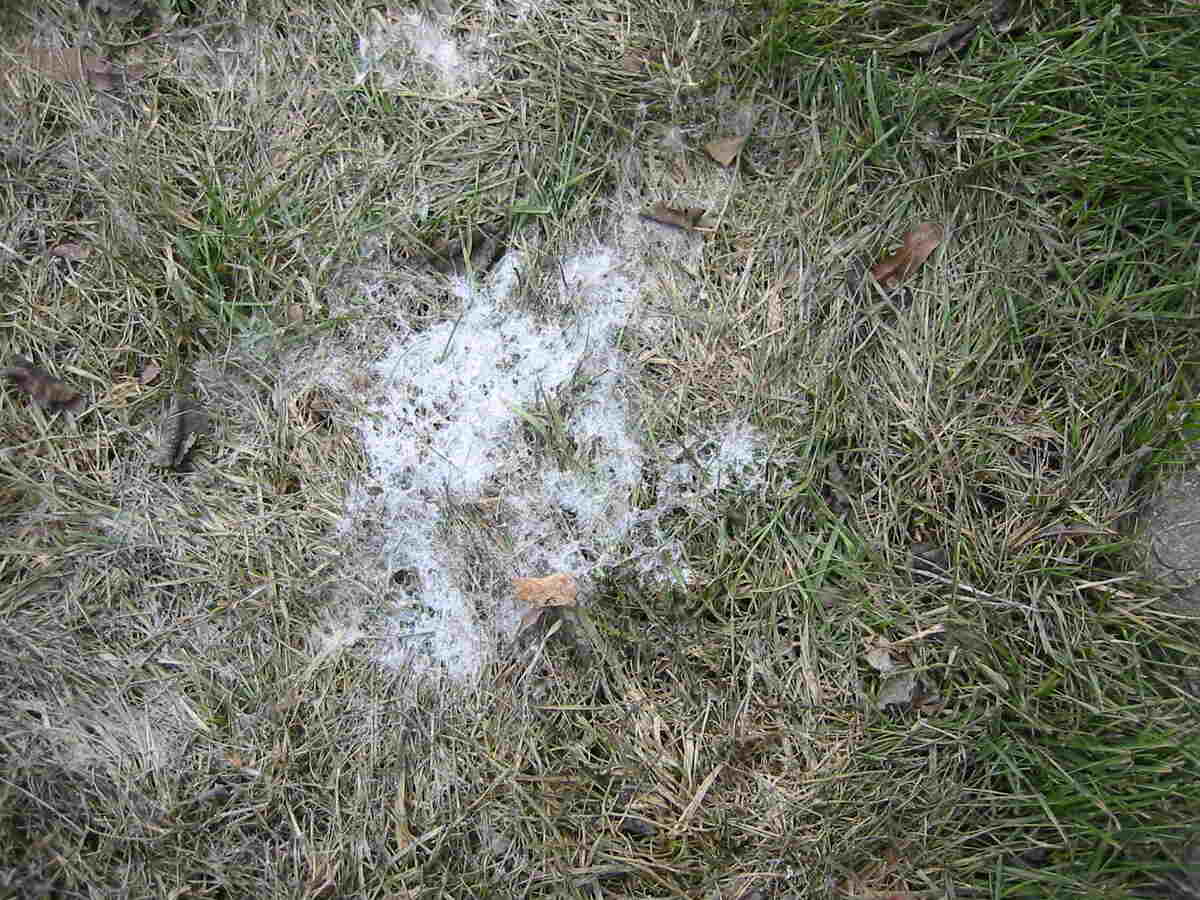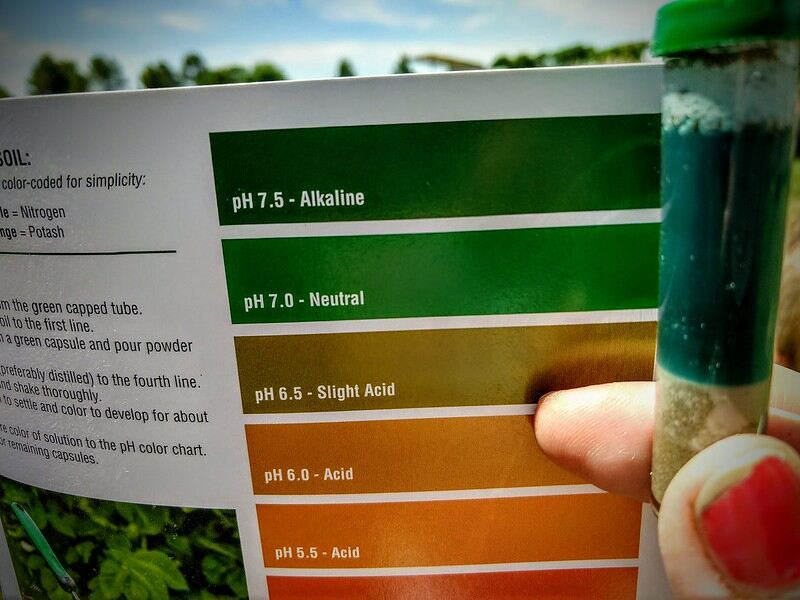
The secret to preventing snow mold is a healthy, clean lawn. Maintain well-drained soil, dethatch and remove fallen leaves, fertilize at the right time, mow the grass until late fall, and don’t let the snow pile up.
What is Snow Mold?

Snow mold is a sneaky winter turf disease that creeps in when temperatures drop, and snow covers your lawn. It’s caused by cold-loving fungi that thrive in grass with poor drainage, excess nitrogen, and lots of organic debris, leaving behind patches of tan, matted grass.
The telltale sign of snow mold infestations is the mycelium (fine fungal strands) often visible near snow banks and on wet grass. It looks like a fuzzy whitish material woven on the grass blades of infected patches.
Pink and gray snow molds are the most common types. They rarely kill your grass but can ruin its appearance and delay recovery in spring.
7 Ways to Prevent Snow Mold
The best defense against snow mold is prevention. Here are the leading lawn care practices that can slow down snow mold infestation and reduce fungi damage.
1. Plant Snow Mold-Resistant Grass
If snow mold damages your lawn year in and year out, consider overseeding with fine fescue varieties, such as hard fescue or creeping red fescue.
Fine fescues have a better natural resistance to snow mold than Kentucky bluegrass, tall fescue, and perennial ryegrass. They still get infected but usually show fewer patches when the snow melts and recover faster in the spring.
2. Clear Away Organic Debris
Piles of dead organic matter provide snow mold fungi with a moist shelter, insulation from freezing temperatures, and a steady food supply. This makes lawns with thick thatch and a heavy cover of fallen leaves more prone to fungal infestations.
To keep your lawn healthy:
- Rake up fallen leaves if they cover over 20% of the lawn.
- Use a mulching mower and mulch the leaves if the coverage is light — less than 50% of the turf surface. Mulching turns leaves into free natural fertilizer.
- Remove thatch if it is thicker than half an inch.
My Tip: Fall can be a busy time. To ensure the turf is prepared for winter, do a final check when you see the first snowfall in the weather forecast. A quick last clean-up can save you hours of lawn repairs next spring.
Related articles:
- “5 Signs Your Lawn Has Excessive Thatch”
- “What to Do With Fallen Leaves”
- “5 Best Ways to Clean Up Leaves in Your Yard”
3. Keep Your Grass Mowed Until Late Fall
Snow flattens tall grass into a thick, tangled mat that traps moisture and heat. Underneath, everything is damp and cool but not freezing — the ideal environment for snow mold fungus to grow.
To prevent your grass from building a nursery for fungi, keep mowing until temperatures drop below 50 to 55 degrees Fahrenheit. This is late October to mid-November when trees lose all their leaves. Plan the last mow of the season at least a week before the first frost or snow.
Should you mow the grass shorter? It depends on how tall you usually keep the grass. Experts recommend mowing 2 to 3 inches tall before the winter.
Professor Peter Lanschoot from Penn State College of Agricultural Sciences said he likes to see homeowners cut the grass to about 3 inches for the last mow. He says there is no reason to cut lower than 2 inches.
“What you don’t want is the grass to be very tall, like 4 or 5 inches. It starts to lay over, and snow gets on top of the grass. It mats it down.”
To prevent grass injury, don’t cut more than ⅓ of the grass blades in one mowing season, ensure the mower blades are sharp, and avoid mowing on wet grass.
4. Limit Nitrogen Fertilizer in Late Fall
“Late fall fertilization pushes turf growth when it should be getting ready for winter and makes the turf much more susceptible to snow mold,” said professor Paul Koch, a turfgrass pathologist at the University of Wisconsin-Madison and an expert in snow mold.
Apply nitrogen fertilizers in late summer and early fall to encourage root growth and healthy grass, but stop a month and a half before the first snow or frost. Cool-season grasses need at least 3 to 4 weeks to slow their growth and harden off for freezing temperatures.
5. Check for Potassium Deficiency

Potassium is an essential nutrient to check for when preparing the lawn for winter. It helps turfgrass improve cold hardiness and disease tolerance.
If last year’s winter damaged your lawn more than usual, it might be due to a potassium deficiency. Take a soil sample and send it for testing to the local Extension Office. The results will tell you how much potassium to use.
Potassium should be applied from late summer to mid-fall to improve absorption and plant use. If you’re late with the application, use a potassium fertilizer (without nitrogen) or a winter fertilizer (with less nitrogen).
6. Apply Preventive Fungicides (if Necessary)
According to Koch, fungicide applications are usually not required on home lawns. Snow mold causes minor to moderate damage, and turfgrass recovers quickly once grass growth starts in the spring.
However, you can use preventive fungicides if you live in an area with heavy snow and want to deal with less damage in the spring. The best time to apply is late fall to early winter “within a couple of weeks prior to snow cover.”
Koch says one application is typically enough to control snow mold on home lawns.
7. Prevent Snow Piling on the Lawn
Piled-up snow melts slower, giving mold fungus more time to grow and damage the grass. To limit snow mounts forming on your turfgrass:
- Install snow barriers. Build snow fences or plant windbreaks to reduce snow drifts during winter.
- Disperse snow banks caused by wind. Strong winds often create snow heaps on the lawn. Use a shovel or a snowblower to disperse the snow.
- Don’t make snow piles on the lawn. When you clear the snow off your driveway and walkways, disperse it evenly instead of piling it in one place on the lawn. It’s easier with a snowblower.
If you live up north and regularly get several inches of snow at one time, it’s hard not to pile snow on the lawn. Just do your best, and focus your efforts in late winter to early spring when the snow starts to melt. It’s when snow molds do the most damage.
Need a Hand With Lawn Care?
Preventing snow mold takes time and effort, but you don’t have to do it alone. Find a trusted lawn care company with LawnStarter to keep your lawn healthy and prepared for harsh winters.
Sources:
- DaCosta, M. Ebdon, J.S. (2023, May). Major Winter Injuries of Cool-Season Turfgrass in New England: Understanding, Prevention and Recovery. https://ag.umass.edu/turf/fact-sheets/major-winter-injuries-of-cool-season-turfgrass-in-new-england-understanding-prevention-recovery
- Koch, P. (2021). When it comes to snow mold, fine fescue is the choice. University of Minnesota. https://lowinputturf.umn.edu/when-it-comes-snow-mold-fine-fescue-choice
Main Photo Credit: noricum / Flickr / CC BY-SA 2.0